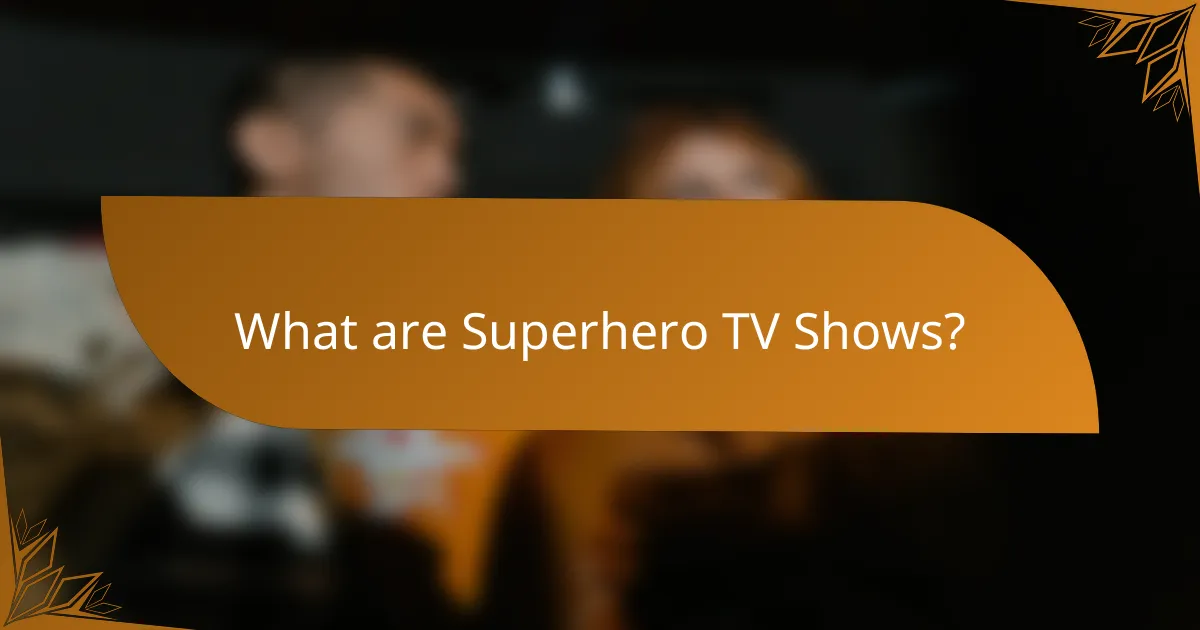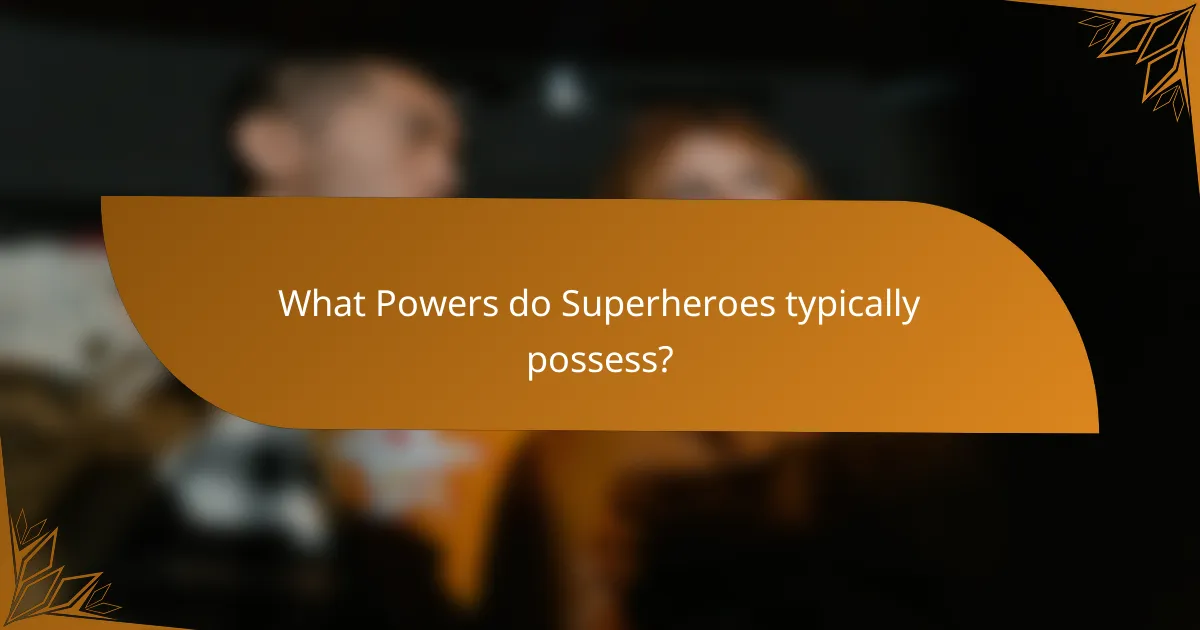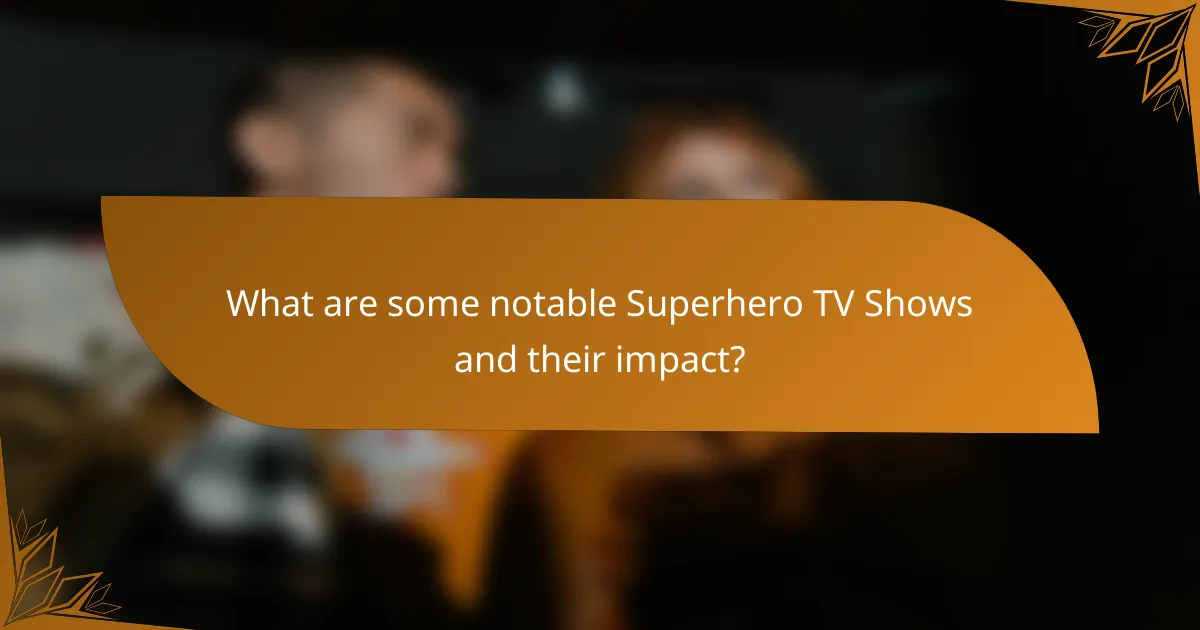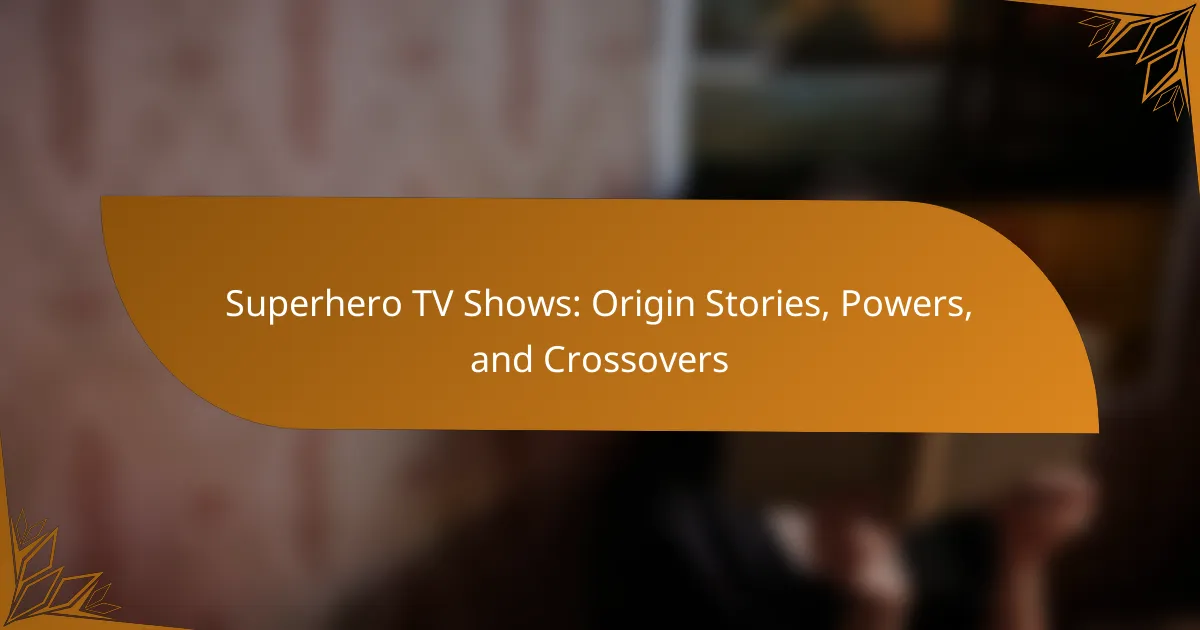Superhero TV shows are television series that focus on characters with superhuman abilities, often derived from comic book narratives. This article explores the origins of these characters, the diverse powers they possess, and the interconnected storylines within various cinematic universes. Notable examples such as “Arrow,” “The Flash,” and “Daredevil” are highlighted for their impact on the genre, showcasing themes of justice, morality, and identity. The popularity of superhero shows has surged since the early 2000s, with these programs accounting for a significant portion of scripted television in the U.S. The article also discusses how these series have influenced audience expectations and shaped future productions in the superhero genre.

What are Superhero TV Shows?
Superhero TV shows are television series centered around characters with superhuman abilities. These shows often adapt comic book narratives and feature iconic heroes and villains. They explore themes of justice, morality, and identity. Popular examples include “Arrow,” “The Flash,” and “Daredevil.” These series typically engage audiences with action-packed plots and character development. Many superhero shows are part of larger cinematic universes, enhancing viewer engagement. They have gained significant popularity and critical acclaim since the early 2000s. According to a 2021 report, superhero shows accounted for over 20% of all scripted television programming in the U.S.
How do Superhero TV Shows differ from other genres?
Superhero TV shows differ from other genres primarily through their focus on extraordinary abilities and larger-than-life characters. These shows often feature protagonists with superhuman powers, which set them apart from typical drama or comedy series. The narrative structure frequently involves origin stories that explain how characters acquired their abilities. This element adds depth and backstory unique to superhero narratives. Additionally, superhero shows often include crossovers with other characters and storylines, enhancing their interconnected universe. This feature is less common in genres such as romance or crime dramas. The blend of action, moral dilemmas, and fantastical elements creates a distinctive viewing experience. Overall, superhero TV shows combine unique attributes that differentiate them from other genres.
What elements define the superhero genre in television?
The superhero genre in television is defined by several key elements. Central characters typically possess superhuman abilities or powers. These abilities often distinguish them from ordinary humans. Origin stories are crucial, providing background on how characters acquired their powers. Conflicts usually arise between heroes and villains, showcasing moral dilemmas. Themes of justice and responsibility frequently underpin the narratives. Additionally, many shows incorporate a shared universe, allowing crossovers between different series. Iconic costumes and symbols are also prevalent, helping to establish character identities. These elements contribute to the genre’s appeal and narrative structure.
What role do cultural influences play in Superhero TV Shows?
Cultural influences play a significant role in shaping Superhero TV Shows. They reflect societal values, issues, and aspirations. For instance, characters often embody cultural narratives relevant to their audience. Diverse representation has increased in response to calls for inclusivity. This shift addresses racial, gender, and socio-economic disparities. Shows like “Black Panther” highlight African culture and heritage. Additionally, the portrayal of villains often mirrors real-world fears and challenges. Historical events influence storylines, making them relatable. Cultural context enriches character development and plotlines.
Why are Origin Stories important in Superhero TV Shows?
Origin stories are important in superhero TV shows because they establish the character’s background and motivations. These narratives provide context for the hero’s powers and values. They often highlight pivotal moments that shape the character’s identity. Understanding a superhero’s origin fosters emotional connection with the audience. It allows viewers to empathize with the character’s struggles and growth. Origin stories also set the stage for future conflicts and relationships. They create a framework for character development throughout the series. This foundational storytelling enhances viewer engagement and investment in the superhero’s journey.
What common themes are found in superhero origin stories?
Common themes in superhero origin stories include transformation, loss, and responsibility. Transformation often involves a significant change, such as acquiring powers or abilities. Loss typically refers to a traumatic event, such as the death of a loved one, that motivates the hero. Responsibility emerges as the hero grapples with their newfound powers and the obligation to protect others. These themes are prevalent in many popular superhero narratives, such as Spider-Man’s Uncle Ben’s death driving his sense of duty and Batman’s parents’ murder shaping his quest for justice. These recurring elements resonate with audiences, making the stories relatable and compelling.
How do origin stories shape character development?
Origin stories shape character development by providing context for a character’s motivations and actions. They explain the circumstances that led to the character’s transformation. This background influences how characters respond to challenges. For instance, a traumatic event can instill a sense of justice or vengeance. Origin stories also establish key relationships and conflicts. These elements often drive the character’s growth throughout the narrative. Furthermore, they create emotional connections with the audience. Viewers understand the character’s struggles and triumphs better through their origins. This depth enhances the overall storytelling in superhero TV shows.

What Powers do Superheroes typically possess?
Superheroes typically possess a range of powers that can include superhuman strength, speed, agility, and intelligence. Many superheroes have the ability to fly or manipulate elements like fire, water, or electricity. Others may have enhanced senses or the capability to heal rapidly. Some superheroes possess telepathic or telekinetic abilities, allowing them to read minds or move objects with their thoughts. Additionally, powers can include shapeshifting, invisibility, or the ability to communicate with animals. These powers often stem from unique origins, such as genetic mutations, advanced technology, or exposure to radiation. The diversity of superhero powers contributes to their appeal and the complexity of their stories in various media.
How are superpowers represented in different shows?
Superpowers in different shows are represented through diverse abilities and thematic interpretations. For example, in “The Flash,” speed is depicted as a means of heroism and responsibility. In contrast, “Jessica Jones” portrays super strength as a metaphor for personal trauma and resilience. “Daredevil” highlights heightened senses to explore themes of justice and morality. Shows like “Heroes” present powers as unique gifts that can isolate individuals. In “Legends of Tomorrow,” powers are often used for comedic effect, showcasing the lighter side of heroism. Each representation serves to enhance character development and plot dynamics. This variety reflects cultural attitudes towards power and responsibility in society.
What are the most common types of superpowers seen in TV shows?
The most common types of superpowers seen in TV shows include super strength, flight, telepathy, and invisibility. Super strength allows characters to lift heavy objects and overpower foes. Flight enables characters to soar through the skies, often depicted in shows like “Superman.” Telepathy involves mind-reading or communication between characters without spoken words. Invisibility allows characters to become unseen, a power frequently showcased in series like “Invisible Man.” These powers are prevalent due to their appeal and the dramatic possibilities they create in storytelling.
How do superpowers affect the plot of a show?
Superpowers significantly shape the plot of a show by driving character development and conflict. They create unique challenges for characters, influencing their motivations and decisions. Superpowers often lead to moral dilemmas, as characters must choose between personal desires and greater responsibilities. This dynamic can introduce tension and drama, essential for engaging storytelling. Additionally, superpowers can facilitate plot progression through action sequences and extraordinary events. They often serve as catalysts for character interactions and relationships, impacting alliances and rivalries. In many superhero shows, the presence of superpowers defines the narrative structure and themes. For instance, in “The Flash,” the protagonist’s speed powers directly affect the story arcs and villain encounters. Thus, superpowers are integral to the plot, shaping the overall narrative experience.
Why do Superhero TV Shows feature crossovers?
Superhero TV shows feature crossovers to enhance viewer engagement and expand storylines. Crossovers allow characters from different shows to interact, creating dynamic narratives. This strategy increases audience interest by merging fanbases. It generates excitement through unexpected character pairings and plot developments. Furthermore, crossovers can boost ratings and viewership numbers. For example, the Arrowverse on The CW successfully utilized crossovers to connect multiple series, resulting in significant viewer increases during event episodes. This collaborative storytelling approach also deepens character development and explores new themes.
What are the benefits of crossovers for storytelling?
Crossover events enhance storytelling by blending different narratives and characters. They create opportunities for character development through interactions with others. Audiences enjoy seeing their favorite characters in new contexts, which boosts engagement. Crossovers can expand the world-building of a franchise, adding depth to existing stories. They often generate increased viewership, as fans from different series come together. This shared audience can lead to higher ratings and revenue. Additionally, crossovers can introduce new plotlines and themes, keeping the content fresh. Historical examples include the “Crisis on Infinite Earths” event, which showcased interconnected story arcs across multiple shows.
How do crossovers enhance viewer engagement?
Crossovers enhance viewer engagement by creating interconnected storylines across different shows. This strategy encourages viewers to follow multiple series to understand the full narrative. Characters from various shows interact, which deepens emotional investment. Fans often discuss and speculate about crossover events, increasing community interaction. According to a study by the Journal of Media Psychology, crossovers can boost viewer loyalty by 25%. This increase in engagement leads to higher ratings and social media activity. As a result, networks benefit from increased advertising revenue.

What are some notable Superhero TV Shows and their impact?
Notable superhero TV shows include “Batman: The Animated Series,” “The Flash,” and “Daredevil.” “Batman: The Animated Series” set a new standard for animated superhero storytelling. It introduced complex characters and mature themes. “The Flash” popularized the idea of a shared universe on television. Its success led to numerous spin-offs within the Arrowverse. “Daredevil” brought a darker, grittier tone to superhero narratives. It was praised for its character development and action choreography. These shows have significantly influenced the portrayal of superheroes in media. They have expanded audiences’ expectations and shaped future productions.
Which Superhero TV Shows have defined the genre?
“Batman: The Animated Series” and “The Flash” have defined the superhero TV genre. “Batman: The Animated Series” set a high standard for storytelling and character development in the 1990s. It introduced darker themes and complex narratives. This show influenced many subsequent animated and live-action adaptations. “The Flash,” premiering in 2014, revitalized the superhero genre on television. It combined humor, heart, and action effectively. Both series have garnered critical acclaim and shaped audience expectations for superhero storytelling.
What innovations did these shows bring to television?
Superhero TV shows introduced several innovations to television. They popularized serialized storytelling, allowing for complex character development over multiple episodes. This format encouraged viewer investment in ongoing narratives. Additionally, these shows often combined genres, blending action, drama, and humor. They also utilized special effects technology to create visually stunning sequences, enhancing viewer engagement. The integration of crossovers between different series expanded shared universes, fostering fan interaction and speculation. These innovations significantly shaped modern television programming and audience expectations.
How have these shows influenced popular culture?
Superhero TV shows have significantly influenced popular culture by shaping media narratives and audience expectations. They have popularized the superhero genre across various platforms, including film, merchandise, and video games. The success of shows like “Arrow” and “The Flash” led to a resurgence in superhero content, impacting viewer preferences. These shows have also inspired fashion trends, with iconic costumes becoming mainstream. Furthermore, they have fostered community engagement through fan conventions and online discussions. Research indicates that superhero narratives often reflect societal issues, enhancing their cultural relevance. The portrayal of diverse characters has contributed to discussions on representation in media. Overall, superhero TV shows have become a vital part of contemporary cultural discourse.
What can viewers expect from future Superhero TV Shows?
Viewers can expect future superhero TV shows to feature deeper character development and complex narratives. These shows will likely explore the psychological aspects of being a superhero. Audiences can anticipate more diverse representation in terms of characters and storylines. Increasingly, shows will include crossovers with other media, enhancing the shared universe experience. The integration of advanced technology in storytelling will create more immersive viewing experiences. Viewers may also see an emphasis on social issues reflected in superhero narratives. The trend towards serialized storytelling will continue, allowing for longer arcs and richer plots. Overall, future superhero TV shows are expected to evolve with audience expectations and cultural relevance.
How are trends in storytelling evolving in the superhero genre?
Trends in storytelling within the superhero genre are evolving towards more complex character development and diverse narratives. Modern superhero stories increasingly focus on the psychological depth of characters. This shift allows for exploration of moral ambiguity and personal struggles. Additionally, there is a growing emphasis on representation and inclusivity in storytelling. Superhero narratives now often incorporate social issues and cultural themes. This evolution is evident in series like “WandaVision,” which blends genres and addresses mental health. Furthermore, the use of non-linear storytelling has become more prevalent. This approach keeps audiences engaged and allows for intricate plot development. Overall, these trends reflect a desire for richer, more relatable stories in the superhero genre.
What new themes and characters might emerge in upcoming shows?
Upcoming superhero TV shows may introduce themes of mental health and identity exploration. Characters may reflect diverse backgrounds and experiences. For example, shows could feature heroes grappling with trauma or societal issues. New characters might include those with unconventional powers or unique origin stories. The trend of anti-heroes may continue to evolve, showcasing morally ambiguous figures. Additionally, themes of community and collaboration could be emphasized through team dynamics. Recent trends like environmentalism may also influence character motivations and story arcs. This evolution aligns with audience demand for deeper narratives and representation in superhero media.
What are the best practices for enjoying Superhero TV Shows?
To enjoy superhero TV shows, start by watching from the beginning of the series. This helps in understanding character development and plot progression. Engage with the source material, such as comic books, to gain deeper insights. Follow online discussions and fan forums to enhance your viewing experience. Consider watching with friends to share perspectives and reactions. Take breaks between episodes to reflect on the story arcs. Pay attention to character backstories, as they enrich the overall narrative. Finally, explore related media like movies and spin-offs for a comprehensive understanding of the universe.
How can viewers enhance their viewing experience?
Viewers can enhance their viewing experience by engaging with the content actively. Watching superhero TV shows with a critical eye allows for deeper appreciation of character development and plot intricacies. Utilizing streaming platforms that offer high-definition options can improve visual clarity. Additionally, using surround sound systems enhances audio immersion, making action scenes more impactful. Following fan forums and social media discussions can provide insights and theories that enrich the viewing experience. Participating in watch parties fosters community engagement and shared excitement. Research indicates that viewers who discuss shows with others report higher satisfaction levels. According to a study by the University of Southern California, social interaction enhances emotional responses to media.
What tips are there for following multiple superhero series simultaneously?
To follow multiple superhero series simultaneously, establish a viewing schedule. This helps in organizing which episodes to watch and when. Use streaming platforms that offer all series in one place. This reduces the hassle of switching between services. Create a dedicated watchlist to track episodes and seasons. This prevents confusion over plotlines and character arcs. Engage with fan communities online for insights and discussions. This enhances understanding of complex narratives. Lastly, consider watching recap videos for quick refreshers on previous episodes. This ensures you stay updated without rewatching entire seasons.
Superhero TV shows are television series that focus on characters with superhuman abilities, often adapted from comic book narratives. This article explores the defining elements of the superhero genre, including the significance of origin stories, the types of powers commonly depicted, and the impact of crossovers on viewer engagement. It delves into how cultural influences shape narratives and character development, as well as the evolution of storytelling trends within the genre. Additionally, the article highlights notable superhero shows and their contributions to popular culture, while offering best practices for viewers to enhance their experience.

